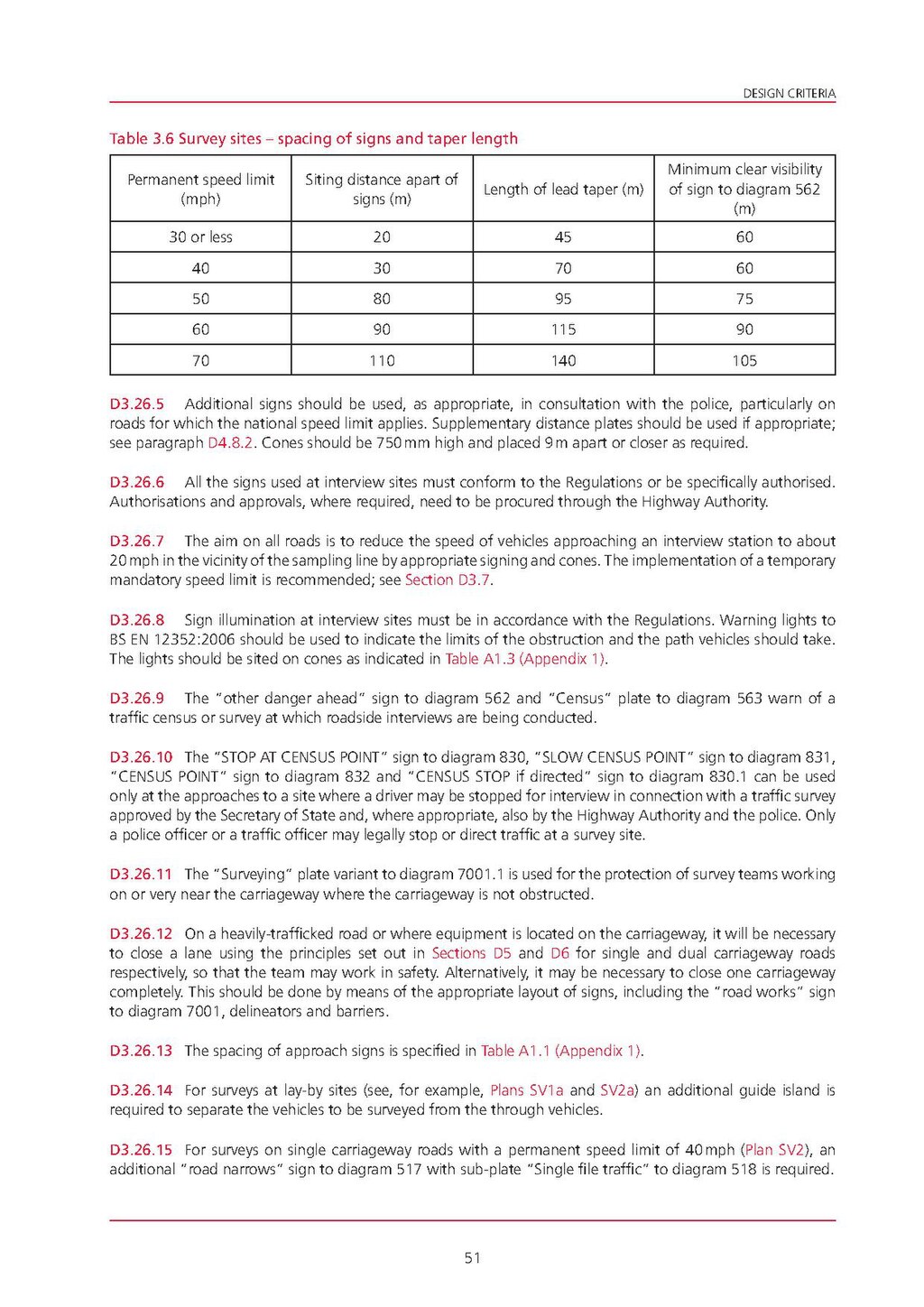| Permanent speed limit (mph) |
Siting distance apart of signs (m) |
Length of lead taper (m) | Minimum clear visibility of Sign to diagram 562
|
| 30 or less | 20 | 45 | 60 |
| 40 | 30 | 70 | 60 |
| 50 | 80 | 95 | 75 |
| 60 | 90 | 115 | 90 |
| 70 | 110 | 140 | 105 |
D3.26.5 Additional signs should be used, as appropriate, in consultation with the police, particularly on roads for which the national speed limit applies. Supplementary distance plates should be used if appropriate; see paragraph D4.8.2. Cones should be 750mm high and placed 9m apart or closer as required.
D3.26.6 All the signs used at interview sites must conform to the Regulations or be specifically authorised. Authorisations and approvals, where required, need to be procured through the Highway Authority.
D3.26.7 The aim on all roads is to reduce the speed of vehicles approaching an interview station to about 20 mph in the vicinity of the sampling line by appropriate signing and cones. The implementation of a temporary mandatory speed limit is recommended, see Section D3.7.
D3.26.8 Sign illumination at interview sites must be in accordance with the Regulations. Warning lights to BS EN 123522:2006 should be used to indicate the limits of the obstruction and the path vehicles should take. The lights should be sited on cones as indicated in Table A1.3 (Appendix 1).
D3.26.9 The "other danger ahead" sign to diagram 562 and "Census" plate to diagram 563 warn of a traffic census or survey at which roadside interviews are being conducted.
D3.26.10 The "STOP AT CENSUS POINT" sign to diagram 830, "SLOW CENSUS POINT" sign to diagram 831, "CENSUS POINT" sign to diagram 832 and "CENSUS STOP if directed" sign to diagram 830.1 can be used only at the approaches to a site where a driver may be stopped for interview in connection with a traffic survey approved by the Secretary of State and, where appropriate, also by the Highway Authority and the police. Only a police officer or a traffic officer may legally stop or direct traffic at a survey site.
D3.26.11 The "Surveying" plate variant to diagram 7001.1 is used for the protection of survey teams working on or very near the carriageway where the carriageway is not obstructed.
D3.26.12 On a heavily-trafficked road or where equipment is located on the carriageway, it will be necessary to close a lane using the principles set out in Sections D5 and D6 for single and dual carriageway roads respectively, so that the team may work in safety. Alternatively, it may be necessary to close one carriageway completely. This should be done by means of the appropriate layout of signs, including the "road works" sign to diagram 7001, delineators and barriers.
D3.26.13 The spacing of approach signs is specified in Table A1.1] (Appendix 1).
D3.26.14 For surveys at lay-by sites (see, for example, Plans SV1a and SV2a) an additional guide island is required to separate the vehicles to be surveyed from the through vehicles.
D3.26.15 For surveys on single carriageway roads with a permanent speed limit of 40mph (Plan SV2), an additional "road narrows" sign to diagram 517 with sub-plate "Single file traffic" to diagram 518 is required.
51
